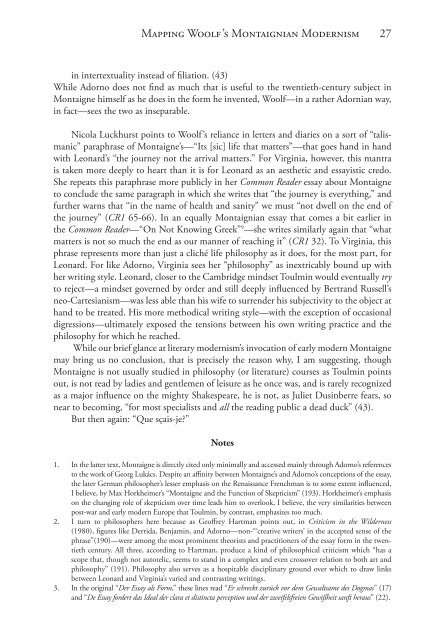Woolfian Boundaries - Clemson University
Woolfian Boundaries - Clemson University
Woolfian Boundaries - Clemson University
Create successful ePaper yourself
Turn your PDF publications into a flip-book with our unique Google optimized e-Paper software.
Mapping Woolf’s Montaignian Modernism<br />
in intertextuality instead of fi liation. (43)<br />
While Adorno does not fi nd as much that is useful to the twentieth-century subject in<br />
Montaigne himself as he does in the form he invented, Woolf—in a rather Adornian way,<br />
in fact—sees the two as inseparable.<br />
Nicola Luckhurst points to Woolf’s reliance in letters and diaries on a sort of “talismanic”<br />
paraphrase of Montaigne’s—“Its [sic] life that matters”—that goes hand in hand<br />
with Leonard’s “the journey not the arrival matters.” For Virginia, however, this mantra<br />
is taken more deeply to heart than it is for Leonard as an aesthetic and essayistic credo.<br />
She repeats this paraphrase more publicly in her Common Reader essay about Montaigne<br />
to conclude the same paragraph in which she writes that “the journey is everything,” and<br />
further warns that “in the name of health and sanity” we must “not dwell on the end of<br />
the journey” (CR1 65-66). In an equally Montaignian essay that comes a bit earlier in<br />
the Common Reader—“On Not Knowing Greek” 9 —she writes similarly again that “what<br />
matters is not so much the end as our manner of reaching it” (CR1 32). To Virginia, this<br />
phrase represents more than just a cliché life philosophy as it does, for the most part, for<br />
Leonard. For like Adorno, Virginia sees her “philosophy” as inextricably bound up with<br />
her writing style. Leonard, closer to the Cambridge mindset Toulmin would eventually try<br />
to reject—a mindset governed by order and still deeply infl uenced by Bertrand Russell’s<br />
neo-Cartesianism—was less able than his wife to surrender his subjectivity to the object at<br />
hand to be treated. His more methodical writing style—with the exception of occasional<br />
digressions—ultimately exposed the tensions between his own writing practice and the<br />
philosophy for which he reached.<br />
While our brief glance at literary modernism’s invocation of early modern Montaigne<br />
may bring us no conclusion, that is precisely the reason why, I am suggesting, though<br />
Montaigne is not usually studied in philosophy (or literature) courses as Toulmin points<br />
out, is not read by ladies and gentlemen of leisure as he once was, and is rarely recognized<br />
as a major infl uence on the mighty Shakespeare, he is not, as Juliet Dusinberre fears, so<br />
near to becoming, “for most specialists and all the reading public a dead duck” (43).<br />
But then again: “Que sçais-je?”<br />
Notes<br />
1. In the latter text, Montaigne is directly cited only minimally and accessed mainly through Adorno’s references<br />
to the work of Georg Lukács. Despite an affi nity between Montaigne’s and Adorno’s conceptions of the essay,<br />
the later German philosopher’s lesser emphasis on the Renaissance Frenchman is to some extent infl uenced,<br />
I believe, by Max Horkheimer’s “Montaigne and the Function of Skepticism” (193). Horkheimer’s emphasis<br />
on the changing role of skepticism over time leads him to overlook, I believe, the very similarities between<br />
post-war and early modern Europe that Toulmin, by contrast, emphasizes too much.<br />
2. I turn to philosophers here because as Geoff rey Hartman points out, in Criticism in the Wilderness<br />
(1980), fi gures like Derrida, Benjamin, and Adorno—non-“‘creative writers’ in the accepted sense of the<br />
phrase”(190)—were among the most prominent theorists and practitioners of the essay form in the twentieth<br />
century. All three, according to Hartman, produce a kind of philosophical criticism which “has a<br />
scope that, though not autotelic, seems to stand in a complex and even crossover relation to both art and<br />
philosophy” (191). Philosophy also serves as a hospitable disciplinary ground over which to draw links<br />
between Leonard and Virginia’s varied and contrasting writings.<br />
3. In the original “Der Essay als Form,” these lines read “Er schreckt zurück vor dem Gewaltsame des Dogmas” (17)<br />
and “De Essay fordert das Ideal der clara et distincta perception und der zweifelsfreien Gewißheit sanft heraus” (22).<br />
27
















